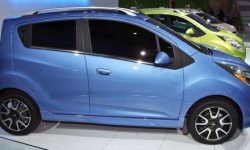Driving at night can be a soothing and enjoyable experience; there are less people on the road, it’s much quieter, and you can’t see much beyond what’s directly in front of you. Pop in some of your favorite music on your car stereo, forget any destinations on your car navigation system, and just drive. Driving at night can be a great experience, but it can also be dangerous – here are some tips for driving after the sun goes down.
Aim Your Headlights – Many people are unaware that your headlights can be aimed a certain direction, much like your mirrors. Also like your mirrors, if they are not aimed correctly it can greatly affect their utility. Make sure your headlights are aimed properly so that they illuminate the road well but do not blind oncoming traffic. You can check your owner’s manual for instructions how to do this.
Also make sure that your headlights are free from haze and grime. Over the years the plastic surface of headlights can become yellowed and hazy, reducing the amount of light coming from your headlamps. If they are foggy or yellowed you can have them re-surfaced, polish them yourself, or replace them to regain proper visibility.
Dim Your Instrument Panel – The many bright lights on your dashboard can be distracting visually from the road. To make sure you can see the road clearly, make sure to dim your dash lights quite a bit when driving at night. Also, avoid leading interior lights on as most illuminate the entire cabin and can also be a distraction.
Wear Proper Eyewear – There are yellow-tinted “night driving glasses” sold that claim they help you see better at night. These claims are false. There is no evidence to substantiate that wearing any kind of tinted sunglasses will help your vision in low light situations. Save your money and skip the glasses; pay attention to the rest of these tips instead.
Watch For Retinas – If you live anywhere with trees, there always seems to be woodland critters about waiting to jump into the road. Before you see them however, you can usually spot your headlights reflecting off of their retinas. Watch far ahead for two little balls of green or yellow light in the distance. If you see them ahead you can slow down to make sure you don’t hit them. If it seems like it’s too late and you see a deer in front of you, slow down as much as possible – if you try to swerve to avoid the deer they will often follow your headlights and you’ll end up hitting them anyway, just faster, and possibly swerve into oncoming traffic.
Don’t Stare at Oncoming Lights – It seems like a no-brainer, but in the quiet, dim hush of your car interior while driving at night, bright lights from oncoming traffic or bright street signs can be a distraction and you can be lulled into staring at them before you realize it.
Keep Your Windshield Spotlessly Clean - Windshields that appear clean in the day can reveal greasy streaks that cloud your vision at night. One trick to remove the streaks is to polish your windshield with newspaper to remove all of the residue. It’s mostly oil that’s the culprit so take care not to touch the inside of your windshield with your hands. In addition, do all you can to avoid getting interior dash conditioners on your windshield – they can be difficult to get off completely.
Bolt-On Fog Lights – Fog lights help drivers see in foggy conditions by directing light low and wide in front of the car. This illuminates a wide swath of road without reflecting the light off of the fog and visually blinding the driver. Fog lights can be useful in clear conditions as well – the positioning of the fog lights casts large shadows over objects and potholes in the road.
Add Auxiliary Lights – If you spend a lot of time driving on country roads at night with little other traffic, adding auxiliary lights may help you see the road properly. They must be exercised with caution however because they are so bright that turning them off requires your eyes to re-adjust, taking up to 30 seconds. A lot can happen in 30 seconds when you’re driving so it’s best to only add and use auxiliary lights when you absolutely need them.
Clean and Adjust Exterior Mirrors – If your mirrors are dirty they will reflect light from cars behind you in a wider, diffused manner that produces glare. Make sure they are clean and pointed slightly down so light doesn’t reflect directly in your eyes.
Keep Your Eyes Healthy - If your own vision is impaired, all of the proper lighting in the world won’t help you see the road clearly. If you wear corrective lenses, make sure your prescription is up to date and that your vision is crisp and clear. If you do not wear any type of corrective lenses, make sure to visit an eye doctor and take an eye exam to make sure you vision is still in top form, especially as you get older





